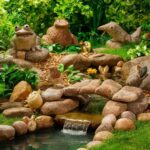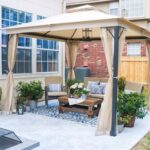When planning your homesteading garden layout, think about creating a self-sufficient oasis that grows food and supports a healthy ecosystem. Consider using raised beds and vertical gardening to make the most of your space. Choose crops that thrive in your climate for a successful garden.
These methods work together to help you harvest plenty of fresh produce in your backyard.
Key Takeaways
- Raised beds
- Vertical gardening
- Sunny spots
- Unconventional planting locations
- Companion planting
Maximizing Garden Space Efficiency
To make the most of your homestead garden space, use raised beds for efficient plant growth. Raised beds help with drainage, prevent soil compaction, and make plant management easier. By raising your planting area, you create a more organized garden layout. This method also allows for better control over soil quality, making it easier to adjust nutrients and pH levels.
Raised beds are great for growing vegetables, herbs, and flowers. You can customize the height and size of the beds to fit your needs. They also provide protection against pests and weeds, leading to healthier plants and better yields. Consider using raised beds in your homestead garden to maximize space and promote successful plant growth.
Utilizing Vertical Gardening Techniques
Consider using vertical gardening techniques in your homestead garden layout.
Use trellises and wall-mounted planters to save space and grow more plants.
Vining crops like cucumbers, beans, and peas do well in vertical setups.
Space-Saving Plant Arrangements
When setting up a vertical garden, choose plants that climb like cucumbers, squash, and beans, for maximum space usage. This method helps improve airflow around plants, reducing the chance of diseases.
Placing plants vertically ensures they get enough sunlight for healthy growth. Plus, harvesting becomes easier with plants growing upward, saving you time and effort.
Vertical Support Structures
To make your homesteading garden more productive, use trellises, arbors, and stakes for vining plants like tomatoes, cucumbers, and beans. These structures help plants grow upward, saving space, improving air circulation, and making harvesting easier. They also make your garden look nice and keep your plants healthy.
With vertical support, your plants get more sunlight, which helps them grow better. Using these structures is a smart way to maximize your garden space and have a thriving and organized garden.
Transforming Sunny Spots Into Gardens
Plant growth and productivity thrive in sunny spots. Sunlight is essential for photosynthesis, which helps plants grow and stay healthy.
Transform these sunny areas into gardens to grow your own fresh produce easily.
Utilizing Sun for Growth
To maximize plant growth and productivity in sunny areas, it’s important to choose sun-loving crops like tomatoes, peppers, and squash. Monitor the amount of sunlight your plants receive each day to ensure they have enough for photosynthesis.
Using vertical space effectively can also help optimize growth. Consider planting climbing vegetables or using trellises to make the most of the available sunlight. Additionally, rotating where you plant your crops can help keep soil nutrients balanced and ensure that all plants receive adequate sunlight.
Maximizing Sunny Areas
Turn sunny areas on your property into gardens for growing plants like tomatoes, peppers, and squash. Position your garden to get sunlight all day. Use raised beds or containers for efficient gardening.
Converting sunny spots into garden beds boosts food production and helps your homestead thrive. Make the most of natural light for successful gardens that support your self-sufficiency goals.
Exploring Unconventional Planting Locations
Here are some tips to help you make the most of your garden space:
- Plant along fences or walls to maximize your planting area and support climbing plants like beans or cucumbers.
- Use containers or raised beds in sunny spots that may not be suitable for traditional beds.
- Place pots, planters, and trellises in unconventional locations like balconies, patios, or hanging from eaves to maximize space.
- Create flower borders along the edges of your garden beds to reduce row lengths, keep pests away, and make your garden look nice while using space efficiently.
Effective Use of Raised Beds and Pots
When planning your homesteading garden, raised beds provide better drainage, soil quality, and fewer weeds.
Place pots strategically for easy movement and to make the most of your space.
These methods can help you grow more and have a great harvest.
Raised Bed Benefits
Raised beds and pots are great for your garden because they help improve soil quality and keep your plants healthy. They have:
- Better soil drainage and aeration for healthier roots.
- Less weeds and easier pest control.
- Easy access for planting and taking care of your plants.
- The right nutrients are needed for your plants to grow well.
Pot Placement Tips
To set up your garden layout for maximum sunlight exposure, place pots strategically based on the sunlight needs of different plants. Use raised beds for veggies for good drainage. Pots work well for herbs and small veggies because they’re portable. Self-watering pots help keep moisture levels steady, especially in hot weather.
Here’s a simple guide for pot placement:
- Tomatoes: Need full sun, so place them in a south-facing area.
- Lettuce: Prefers partial shade, so an east-facing spot is ideal.
- Peppers: Thrive in full sun, so place them in a west-facing area.
Space Maximization Strategies
To make the most of your home garden space, use raised beds and pots. Raised beds improve soil drainage, aeration, and overall yield. They also help control soil quality and reduce weeds.
Pots are great for small spaces like patios, allowing you to move plants for better sunlight and space. Both raised beds and pots make gardening easier and more productive.
Try different setups to maximize your gardening space efficiently.

Implementing Trellises for Plant Support
When you use trellises for plant support in your garden, you can enjoy these benefits:
- More Space: Trellises help you grow more plants in a smaller area.
- Healthier Plants: Vining crops like cucumbers, peas, and beans grow better on trellises.
- Less Disease: Air circulates better around plants on trellises, reducing the risk of diseases.
- Easy Harvesting: It’s easier to pick fruits and vegetables when they grow vertically on trellises.
- Saves Money: Making trellises from bamboo, PVC, or wood is affordable.
- Better Yields: Plants on trellises produce more crops.
Trellises are great for container gardens too, preventing plants from spreading out too much and getting more sunlight for higher yields.
Companion Planting for Space Optimization
Companion planting helps plants grow better together by using their natural abilities. Here are some ways it can help your garden:
- Plants like marigolds can keep pests away.
- Some plants, like beans and corn, can help each other grow better.
- Certain plants attract good bugs, like ladybugs.
- By planting certain plants together, you can use fewer chemicals.
These tips can make your garden healthier and more eco-friendly.
Soil Preparation and Maintenance Strategies
To make your homestead garden healthy and productive, start by testing your soil for nutrients and pH levels. Add organic materials like compost to give your plants the nutrients they need.
Cover crops can help improve soil quality, prevent erosion, and control weeds. Rotate your crops regularly to keep the soil healthy and reduce the risk of pests and diseases.
Mulch your garden beds to retain moisture, regulate temperature, and minimize weeds. These steps will create a fertile environment for your garden to thrive.
Climate-Based Crop Selection
To pick the best crops for your homestead garden, consider your region’s climate. Look up USDA Hardiness Zones to see which plants do well. Check local gardening guides for more tips.
Choose crops that match your area’s rainfall and sunlight. This way, your plants will thrive with the right conditions.
Sunlight Requirements for Plant Growth
Different plants have different sunlight needs for optimal growth in your garden. Sunlight is crucial for plant photosynthesis, which is essential for their growth and development.
Plants like tomatoes and peppers love full sun and need 6–8 hours of direct sunlight every day. On the other hand, leafy greens such as lettuce and spinach prefer some shade to prevent wilting and bolting.
To make sure your plants get enough sunlight, keep an eye on how the sunlight changes throughout the day in your garden. Watch how shadows move and adjust where you place your plants accordingly. By knowing the light requirements of each plant type, you can plan your garden layout to give them the best sunlight exposure.
Sustainable Watering Practices
To help your garden grow well, make sure you water your plants the right way. Here are some easy tips to follow:
- Check your soil to see if it needs water. Stick your finger in the soil to know if it’s dry or wet.
- Give your plants about 1 inch of water every week for them to grow nicely.
- Use a timer on your hose to water your plants regularly and evenly.
- Try drip irrigation systems to water your plants right at the roots, which helps them grow stronger.
Ensuring Garden Ecosystem Health
To maintain a healthy garden ecosystem, you can invite helpful bugs and bees to your garden. These tiny allies can control pests like aphids and help plants grow by pollinating them. By planting certain flowers, you can attract ladybugs, bees, praying mantises, lacewings, and hoverflies to your garden. These insects can naturally keep harmful bugs in check and ensure your plants thrive.
To prevent soil exhaustion and pests, try rotating your crops each season. This helps maintain soil fertility and disrupts pest life cycles, keeping your garden healthy. By growing a variety of plants, you can create a diverse ecosystem that supports beneficial insects and wildlife. Avoid using chemical pesticides and fertilizers to protect the environment and maintain a balanced garden for years to come.
Frequently Asked Questions
How Do You Layout a Homestead Garden?
To set up a homestead garden, plant crops that help each other grow well together. Use rows or raised beds for planting and save space for young plants. Choose vegetables that can be stored for a long time. Even people in cities can homestead by growing plants in containers.
How Do I Set Up a Self-Sufficient Homestead?
When starting a self-sufficient homestead, plan your layout with staple crops, animals, and eco-friendly practices like composting. Grow high-yield, nutrient-rich crops to feed your family effectively.
How Do You Set Up a Self-Sustaining Garden?
To set up a self-sustaining garden, plan the layout with crop rotation and companion planting. Use perennials for long-lasting plants, collect rainwater, make compost, and spread mulch. Different plants keep away pests and boost soil health for a healthy garden that needs little upkeep.
How Big of a Garden Do I Need to Be Self-Sufficient?
To be self-sufficient, you need a garden that is at least 1,000 square feet. It’s better to have a larger plot if you want to grow different types of crops. You can start small and then expand gradually to grow important crops like beets, onions, and potatoes effectively.
Conclusion
In short, organizing your garden layout is important for homesteading success. Use space wisely, try vertical gardening, and pick plants that suit your area’s weather.
Keep the soil healthy, water thoughtfully, and give your plants enough sunlight.
With good planning, you can have a garden that gives you lots of food and supports your homesteading lifestyle.











